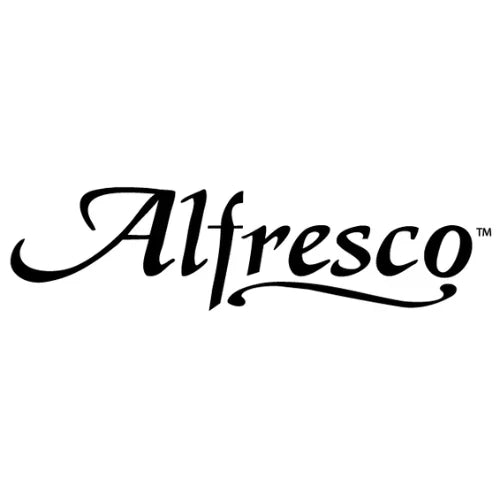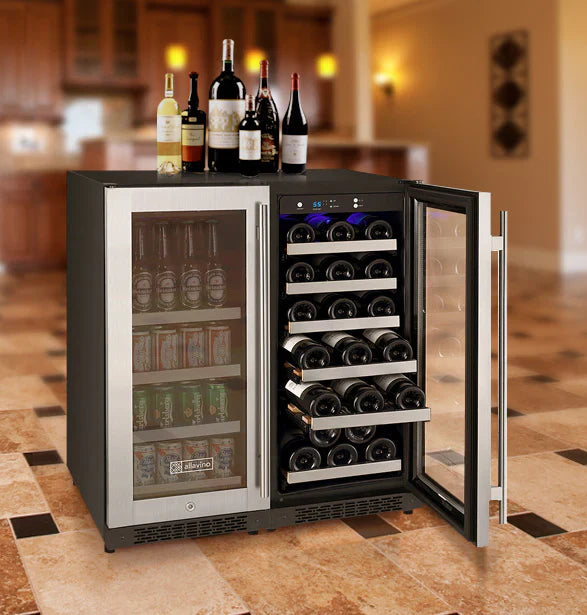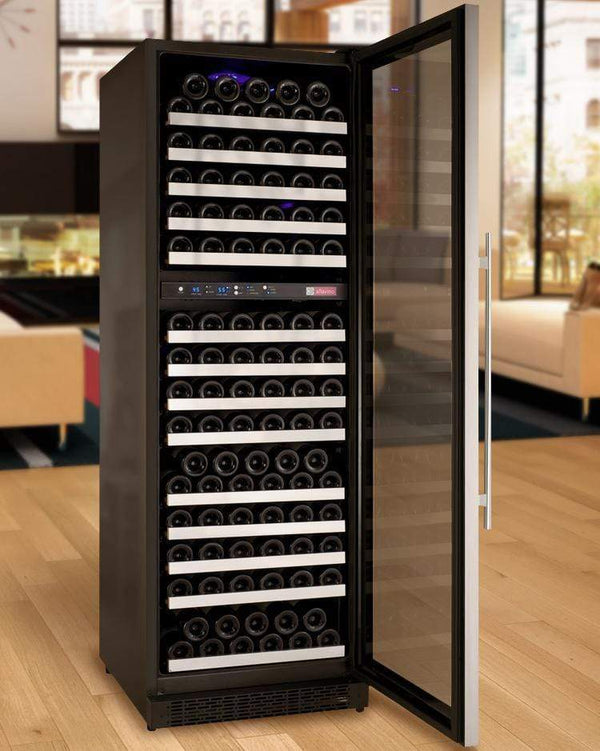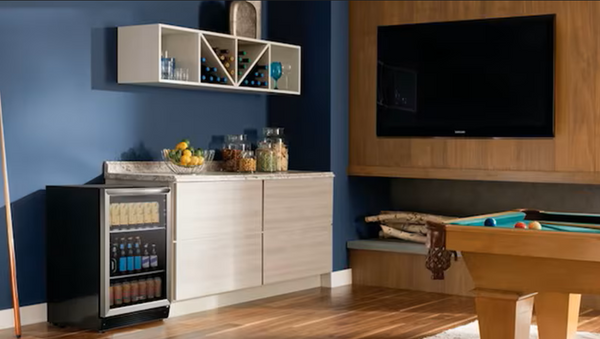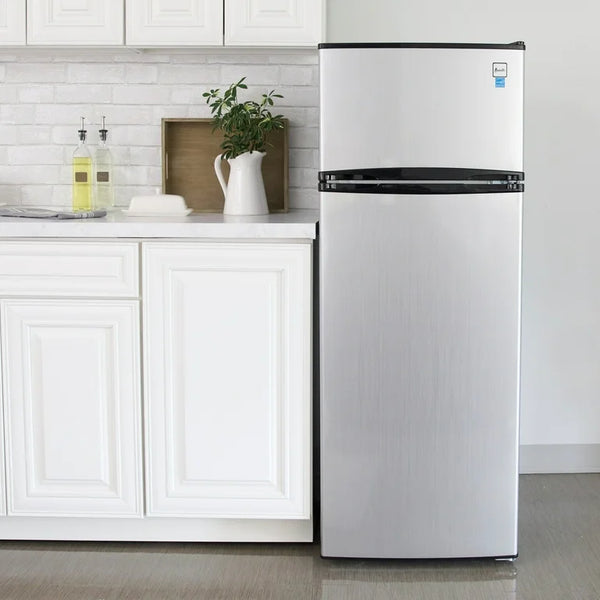Designing a Wine Cellar?
Let’s get it right.
Our specialists review your room layout, insulation, and heat load to recommend the correct cooling system for stable temperature and reliable climate control.
Best Wine Cooling Brands: Keep Your Collection in Perfect Condition
The Importance of Choosing the Right Wine Cooling Solution
By Jim Hopper, Wine Cooling Expert
Proper wine storage is essential for preserving the flavor, aroma, and value of your wine collection. Whether you’re a casual enthusiast or a serious collector, choosing the right wine cooling unit—and the brand behind it—can make all the difference. In this guide, we’ll explore the best wine cooling brands on the market, what sets them apart, and how to select the perfect solution for your needs.
What Is a Wine Cooling Unit?
Wine cooling units are specialized systems designed to maintain the ideal temperature and humidity for wine storage. Unlike standard refrigerators, these units offer precise control, ensuring your wines age gracefully and remain protected from heat, dryness, and vibration. There are several types to consider:
- Through-the-wall units: Self-contained systems that install directly into a wall and vent into an adjacent room or outdoors.
- Split systems: Feature separate evaporator and condenser units, reducing noise and heat in the cellar.
- Ducted systems: Circulate cooled air via ductwork, offering flexible installation and quiet operation.
- Cabinet/cellar coolers: Compact units designed for wine cabinets or small cellars.
Types of Wine Cooling Units
There are several main types of wine cooling units, each designed to suit different cellar sizes, installation preferences, and noise requirements. Understanding the differences will help you choose the right system for your collection:
1. Through-the-Wall (Self-Contained) Units

- Description: All-in-one units that install directly into a wall, venting warm air into an adjacent room or outdoors.
- Subtypes: Some models offer ducting options for greater flexibility.
- Best for: Small to medium cellars, DIY installations, and budget-conscious buyers.
- Pros: Easy to install, cost-effective, minimal maintenance.
- Cons: May be noisier and take up space inside the cellar.
2. Split Systems

- Description: Feature separate evaporator (inside cellar) and condenser (outside cellar) units, connected by refrigerant lines.
-
Subtypes:
- Ductless split: The evaporator is mounted inside the cellar, condenser outside—no ductwork needed.
- Ducted split: Cool air is delivered via ducts from a remote evaporator, offering a cleaner look.
- Best for: Cellars near living spaces where noise reduction is important.
- Pros: Quiet operation inside cellar, flexible placement, efficient cooling.
- Cons: Requires professional installation, higher upfront cost.
3. Ducted Systems

- Description: Cooled air is distributed via insulated ductwork from a self-contained or split cooling unit installed remotely.
-
Subtypes:
- Fully ducted self-contained: Both evaporator and condenser are housed together outside the cellar, air is ducted in/out.
- Ducted split: Separate evaporator and condenser, both may be located outside the cellar, with air ducted in.
- Best for: Large or high-end cellars, situations where a quiet, hidden system is desired.
- Pros: Virtually silent in the cellar, flexible design, no visible equipment inside.
- Cons: Most expensive, requires careful planning and professional installation.
4. Cabinet and Compact Cooling Units

- Description: Small, self-contained units designed for wine cabinets, closets, or small cellars.
- Best for: Compact spaces or collectors with limited bottle storage.
- Pros: Easy to install, fits in tight spaces, affordable.
- Cons: Limited capacity, not suitable for large cellars.
Quick Reference:
| Type | Typical Use | Pros | Cons |
|---|---|---|---|
| Through-the-Wall | Small/medium cellars | Easy to install, affordable | Noisier, visible |
| Split (Ductless/Ducted) | Noise-sensitive areas | Quiet, flexible | Professional install needed |
| Ducted | Large/high-end cellars | Silent, hidden | Most expensive |
| Cabinet/Compact | Cabinets/small spaces | Small, easy to install | Limited capacity |
Key Factors to Consider When Choosing a Wine Cooling Brand
Selecting the right brand goes beyond just picking a unit. Consider these factors to ensure you get the best fit:
- Temperature and humidity control: Look for digital controls and adjustable settings.
- Unit capacity: Match the unit’s cooling power to your cellar’s size (measured in cubic feet).
- Installation requirements: Consider DIY-friendly options versus those needing professional installation.
- Noise level: Important for cellars near living spaces.
- Reliability and warranty: Choose brands known for durability and strong warranty support.
- Customer support: Access to expert advice and after-sales service can be invaluable.
Overview of the Top Wine Cooling Brands
Several brands consistently stand out for their quality, innovation, and customer satisfaction. Below is an overview of the leading names in wine cellar cooling:
Each of these brands offers a range of models and technologies to suit different cellar sizes, installation needs, and budgets.
Detailed Reviews of the Best Wine Cooling Brands
WhisperKOOL

WhisperKOOL is renowned for its innovative cooling technology and wide range of units suitable for both residential and commercial applications. Their self-contained, split, and ducted systems are designed for efficiency and quiet operation. Popular models like the SC PRO series and Extreme series are praised for their reliability and flexible installation options.
Best for: Homeowners seeking a balance of performance, quiet operation, and ease of installation.
Interested in learning more about WhisperKOOL’s range and performance? Explore these in-depth resources:
- WhisperKOOL SC PRO 4000 Product Review
- WhisperKOOL Slimline LS Cooling Unit
- WhisperKOOL Phantom Series Product Review
- All About WhisperKOOL XLT 4200
- WhisperKOOL Quantum Series for Challenging Wine Cellars
- Overview: WhisperKOOL Features
- Why WhisperKOOL Cooling Units Are the Best Solution
- The Secret to Madison Wine Company’s Success: WhisperKOOL Cooling Units
Breezaire

Breezaire has built a reputation for durable, user-friendly wine cooling systems. Their through-the-wall and split systems feature adjustable digital controls and vibration-dampening technology. Models like the WKL and WKSL series are ideal for those looking for dependable, low-maintenance solutions.
Best for: Collectors who value reliability and straightforward operation.
For more on Breezaire’s technology and how to select the right unit, see our Breezaire wine cooling systems guide and Breezaire WKL Series review.
CellarPro
CellarPro offers American-made wine cooling units with advanced features such as digital temperature and humidity control, multiple installation options, and robust warranties. Their systems are suitable for both small cabinets and large commercial cellars.
Best for: Wine lovers who want customizable solutions and high-quality components.
Wine Guardian

Wine Guardian is known for its premium ducted and split systems, offering precise environmental control and flexible installation. Their units are suitable for a wide range of cellar sizes and can be configured for unique spaces.
Best for: Those seeking commercial-grade performance and advanced humidity control.
For a comprehensive look at Wine Guardian’s options and best practices, see:
- Introducing the Wine Guardian Cooling Systems and Humidifiers
- Wine Guardian Wine Cellar Cooling Systems Resource
- Wine Guardian Cooling Systems: The Optimal Solution for Your Cellar
- Wine Guardian: Best Cooling Units for Your Wine Cellar
Ultra Wine Racks

Ultra Wine Racks provides both storage solutions and cooling units, with a focus on modern design and ease of integration. Their cooling systems are often chosen for contemporary cellars and wine walls.
Best for: Modern cellars and design-conscious collectors.
CellarCool

CellarCool delivers affordable, easy-to-install cooling units ideal for smaller cellars and entry-level collectors. Their through-the-wall models are especially popular for DIY installations.
Best for: Budget-conscious buyers and small cellar owners.
Want more details on CellarCool models and setup? Check out our CellarCool CX Series overview and CellarCool features and installation guide.
Comparison Table: Top Wine Cooling Brands
| Brand | Types Offered | Capacity Range | Notable Features | Best For |
|---|---|---|---|---|
| WhisperKOOL | Through-wall, split, ducted | 300–3,500+ cu ft | Quiet operation, digital controls | Home/casual & serious collectors |
| Breezaire | Through-wall, split | 140–2,000 cu ft | Vibration control, easy installation | Reliability-focused users |
| CellarPro | Through-wall, split, ducted | 100–2,000+ cu ft | Made in USA, advanced controls | Custom setups, high-end users |
| Wine Guardian | Ducted, split | 200–5,000+ cu ft | Commercial-grade, humidity control | Large/commercial cellars |
| Ultra Wine Racks | Through-wall | 100–2,000 cu ft | Modern design, modular | Modern cellars |
| CellarCool | Through-wall | 265–2,000 cu ft | Affordable, DIY-friendly | Budget/small cellars |
Installation and Design Considerations
Choosing the right wine cooling unit isn’t just about brand or features—it’s also about how the system will fit into your cellar and home. Here’s what to keep in mind when planning installation and integrating a cooling unit into your wine cellar design:
Installation Requirements by System Type
-
Through-the-wall units:
These self-contained systems are popular for their straightforward installation. Many models can be installed as a DIY project, as they fit between standard wall studs and vent into an adjacent room or outdoors. However, you’ll need access to a dedicated power source and a way to manage condensate drainage. -
Split systems:
Installation is more complex, involving separate evaporator and condenser units connected by refrigerant lines. These typically require a professional HVAC technician, but they offer greater flexibility for placement and can minimize noise and heat within the cellar. -
Ducted systems:
Ducted units can be installed remotely, with cooled air delivered via insulated ductwork. This setup allows for a quieter cellar and more flexible design options but usually requires professional installation and careful planning for duct routing and ventilation. -
Cabinet/cellar coolers:
Compact and designed for small spaces, these units are generally easy to install within wine cabinets or closets. Some may be DIY-friendly, while others benefit from professional setup to ensure optimal performance.
For step-by-step installation tips, see our CellarCool installation and features guide.
Integrating Cooling Units into Wine Cellar Design
-
Placement:
Consider the visual and acoustic impact of the unit. Through-the-wall and cabinet units are visible in the cellar, while split and ducted systems can often be hidden from view for a cleaner look. -
Venting and Ducting:
Proper venting or ductwork is critical for efficient operation and maintaining the desired temperature and humidity. Ensure there’s space for exhaust and access for maintenance. -
Insulation and Vapor Barriers:
For any cellar, quality insulation and a vapor barrier are essential to prevent heat and moisture intrusion, which can overwork your cooling system.
Leverage Professional Design Services
Many leading brands and retailers offer complimentary wine cellar design consultations. These services help you plan the layout, select compatible cooling units, and ensure your installation meets both technical and aesthetic needs. Taking advantage of expert advice can save time, prevent costly mistakes, and result in a cellar that’s both functional and beautiful.
How to Choose the Right Brand for Your Needs

- Measure your cellar: Calculate the cubic footage to determine unit size.
- Decide on installation type: Through-the-wall for ease, split/ducted for quiet and flexibility.
- Set your budget: Higher-end brands offer more features and longer warranties.
- Consider noise and placement: For cellars near living spaces, prioritize quiet models.
- Check for support and warranty: Ensure the brand offers strong after-sales service.
Further Reading & In-Depth Reviews
Explore these detailed reviews and guides for more insight on top brands and models:
- WhisperKOOL SC PRO 4000 Product Review
- WhisperKOOL Phantom Series Product Review
- Breezaire: Exploring Wine Cooling Systems and Selecting the Right Unit
- CellarCool CX Series Overview
- Introducing the Wine Guardian Cooling Systems and Humidifiers
- Wine Guardian: Best Cooling Units for Your Wine Cellar
Conclusion
Choosing the best wine cooling brand is a crucial step in protecting your wine collection. By considering your cellar’s size, your installation preferences, and your budget, you can find a reliable cooling solution from trusted brands like WhisperKOOL, Breezaire, CellarPro, and others. For personalized advice, consult with wine cellar experts or take advantage of design services offered by leading retailers.
Ready to Protect Your Wine Collection? Get Expert Help Today!
Have questions or need personalized recommendations for your wine cellar? Our team of wine cooling experts is here to help you choose the perfect solution for your needs.
Call Us: 1-888-407-7770
Email Us: support@winecoolersempire.com
Want help designing your dream wine cellar?
Start Your Wine Cellar Design Consultation
Whether you’re building a new cellar or upgrading your current setup, reach out today for friendly advice, custom quotes, and expert support.
📚 Frequently Asked Questions (FAQs)
What’s the best wine fridge for serious collectors?
What are the ideal conditions for wine storage?
What types of wine are suitable for wine coolers?
Should I store wine in a wine cooler?
Are wine fridges good for long-term wine storage?
What wine dispenser keeps wine fresh after opening?
What types of wine age best in long-term storage?
What’s the ideal temperature setting for a wine fridge?
How can I prevent wine from spoiling?
Why do wine coolers cost so much?

Designing or Upgrading a Wine Cellar?
We got you! Here at Wine Coolers Empire, we will guide you in building your dream wine cellar.



